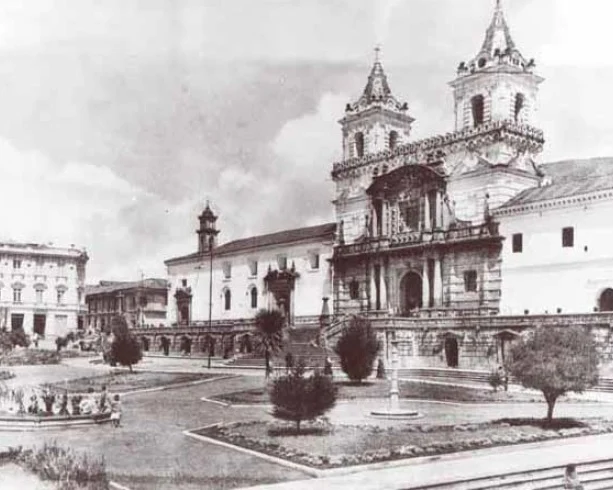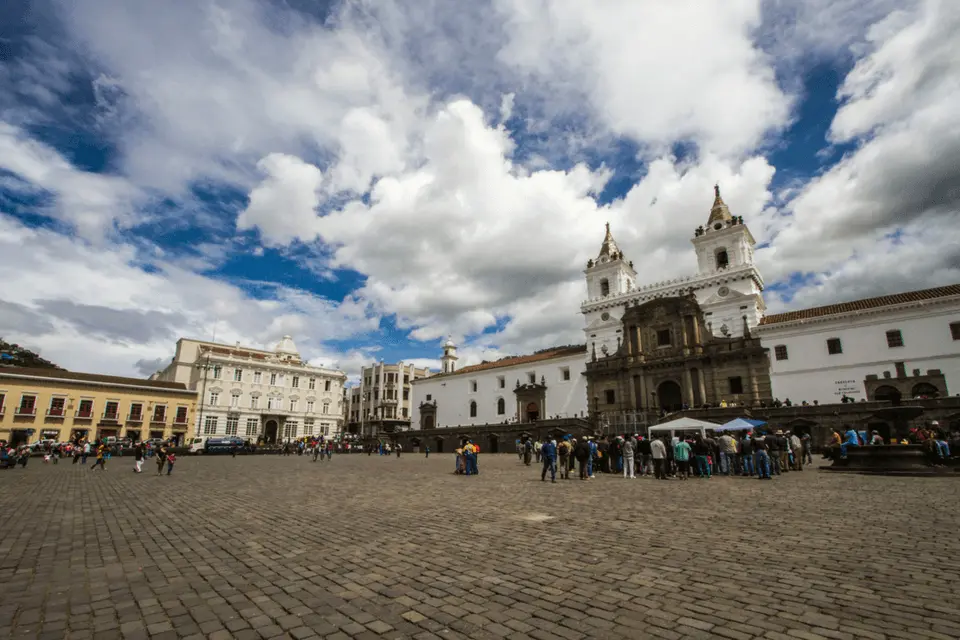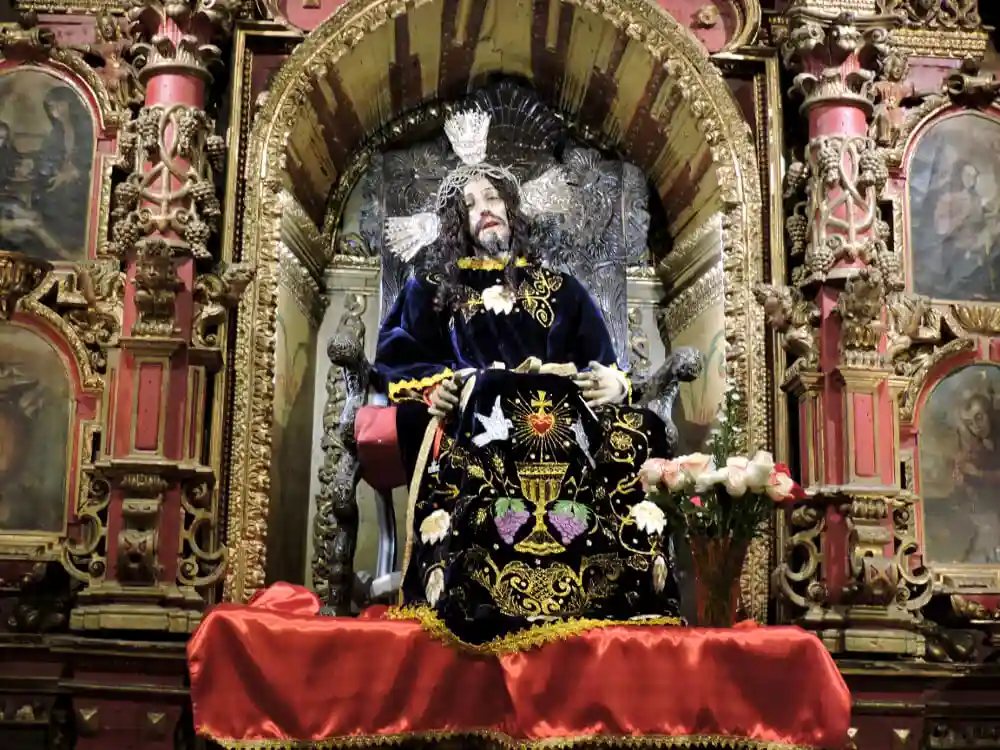Plaza San Francisco in Quito greets you in the morning when you open your curtains onto the sunny square; accompanies you to lunch in the restaurant; toasts to your day over cocktails on the roof terrace; and bids you goodnight as you soak in your bathtub. A solid and constant reminder of where you are, this plaza, and the entire San Francisco religious complex, is a symbol of the magnificence of Quito’s Old Town and serves as one of Ecuador’s most enchanting tourist attractions.
In contrast, the San Francisco Complex in San Francisco, California, showcases a different kind of marvel. While the great-grandfather of Catholic construction in Quito, San Francisco – with its twin white spires brilliant against the blue of the Andean sky – stands as a testament to religious devotion and architectural beauty, the San Francisco Complex presents a modern narrative. It’s a hub of legal, cultural, and artistic endeavors nestled in the heart of San Francisco. From the intricate cases handled in the Complex Civil Litigation departments to the creative pulse beating through The Complex-SF recording and art production space, this complex encapsulates the dynamic spirit of San Francisco. Here, history meets progress, tradition blends with innovation, and every street corner tells a story of diversity and transformation. Whether it’s the civic pride radiating from the renovated San Francisco Civic Center Complex or the artisanal delights awaiting at the Ferry Building Marketplace, the San Francisco Complex offers a multifaceted experience that mirrors the eclectic essence of the city itself.

Once the royal palace of Huayna Cápac, the great Inca Emperor, it was also possibly a ceremonial temple for this pre-Columbian society before it became the headquarters of the Catholic Franciscan order. The San Francisco complex weaves together each of the threads of Quito’s cultural fabric: it’s a church, a museum, a home and a monument. This is why it merits hours of exploration during your stay at Casa Gangotena in the heart of Quito’s Old Town – it is one of Ecuador’s best tourist attractions.
The Church and the San Francisco Complex
In the past, the great doors of the main San Francisco church were strictly reserved for the very wealthy of the capital. The poor, slaves and indigenous people had to take the side entrance to the Chapel of Cantuña.
The church of San Francisco opens atop a curious staircase that is half concave and half convex, sweeping dramatically up from the square to the atrium. This staircase and parts of the façade show influence of Italian mannerisms.

The choir of the church is a gem, surrounded by a series of gruesome portraits of saints and their particular form of murder. Look up and admire the elaborate and beautiful wooden mudejar ceiling – built without using a single nail – that serves as a testament to the influence of Islamic art that was transported here to the heart of the Andes.
With Casa Gangotena, you can access an exclusive part of the church, normally only unlocked for brown-robed friars. Heading up a narrow staircase, you emerge onto the roof, eye-to-eye with the great bells themselves. For a moment, the entire city is yours.
The church itself is a baroque wonder, brimming with gold leaf ornament, canvases, sculptures, murals and retablos. It was subject to an extensive restoration project in the 2000’s that returned its many amazing pieces of art to their full glory. Masses are given throughout the morning and evening.
Chapel of Cantuña

Located a few steps to the left, the Chapel of Cantuña was once reserved for all those who didn’t make the cut in the main church. Despite being reserved for the most humble, the chapel is anything but simple – it is smothered in ornamental angels, garlands, mirrors and stars. The Chapel now stands as a precious example of the Quito School of Art, echoing the intricate and multifaceted nature of the San Francisco Complex.
There is some ambiguity over who, exactly, the chapel was named after. There were at least two indigenous men by the name of Cantuña who were connected to the San Francisco Complex, but only one of them was buried alongside his family in one of the altars, with a beautiful carving by Father Carlos. This intertwining of personal histories with the architectural grandeur of the complex adds layers of narrative and mystique to its walls.
The Cantuña that most Quiteños will be able to tell you about is Francisco de Cantuña, whose name is as legendary as his trickery of the Devil. You can discover more about this Old Town folklore with Casa Gangotena’s exclusive Devil’s Tour of the chapel, guided by Satan himself, a fun and alternative way to experience one of the tourist attractions of Ecuador’s capital – Quito. This tale of wit and cunning further enriches the lore surrounding the San Francisco Complex, making it not just a site of architectural and historical significance, but also a central figure in the collective memory and imagination of Quito.
Pedro Gocial Museum
The collection displayed in this charming art museum is a very small percentage of what is held within the cavernous vaults of the Franciscan monastery. Great mestizo sculptors like Pampite, Caspicara and Bernardo de Legarda share the space with Bernardo de Rodríguez and his huge canvases such as “San Antonio preaching to the fish.”
Some of these dramatic works have a way haunting the mind. Keep an eye out for the painting of the son of the last Incas (Francisco Atauchi) to be baptized by friars and the small, medium and large Winged Virgins by Legarda.
The Brewery
Quito is now famous for its craft beerwith small-time breweries becoming Ecuador tourist attractions in-and-of-themselves. But the city’s history of microbreweries began long ago, right there inside the monastery of San Francisco. In fact, the Flemish monks who founded the church and monastery in the 16th century were the first to brew beer in the Ecuadorian capital. Clearly, they obviously missed the creature comforts of their homeland!
Only recently opened to the public, San Francisco’s brewery was manned by beer-brewing monks until about 50 years ago. Now a museum, the space holds the great oak fermentation barrels and displays brilliant photos of the monks operating machines, wielding great wooden paddles in their modest brown cloaks that are belted with rope.
The monks weren’t even brewing the beer for profit or for entertainment. The 3-5% proof beverage was simply a safer alternative to water that the monks would drink themselves or give to the poor!



